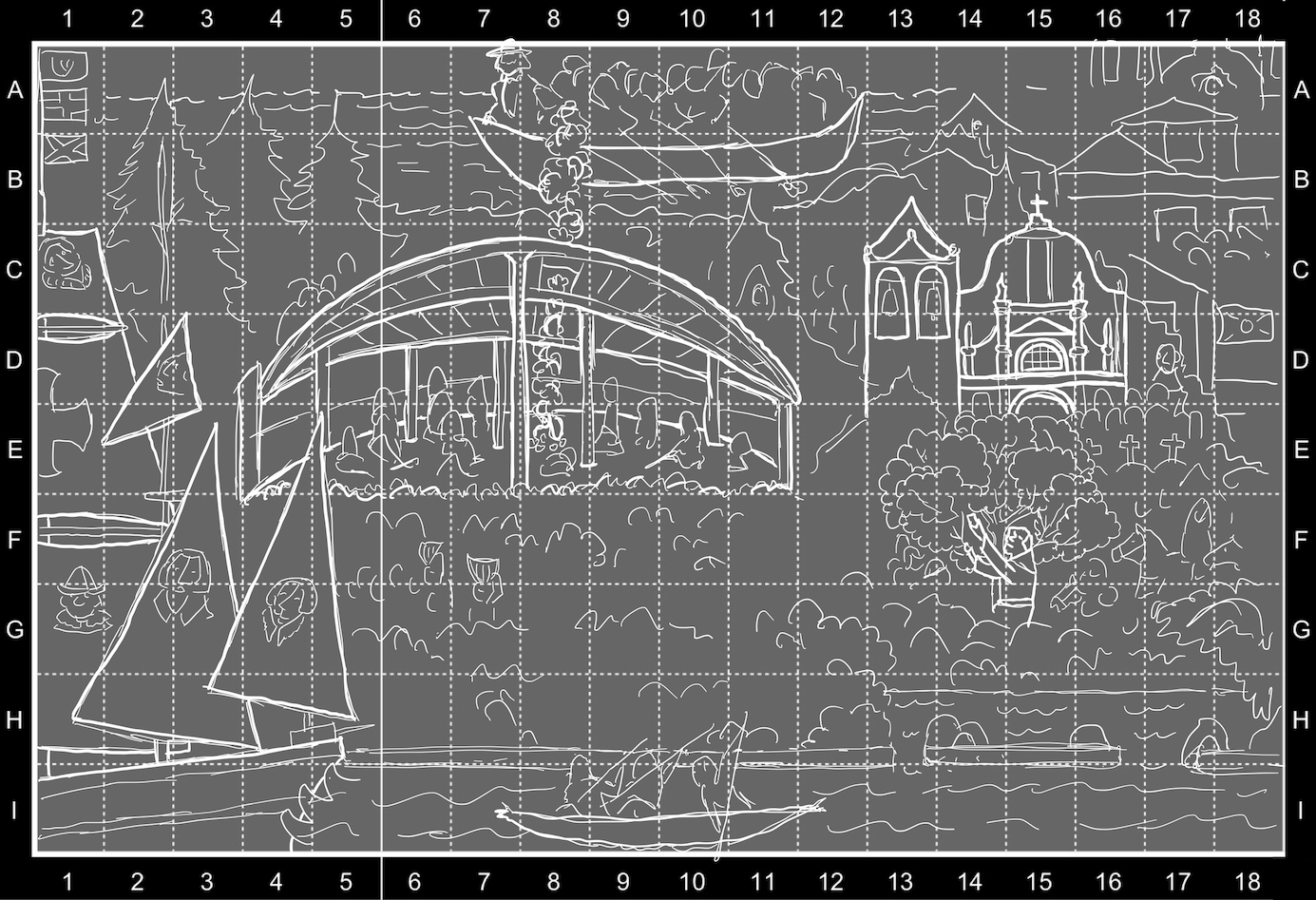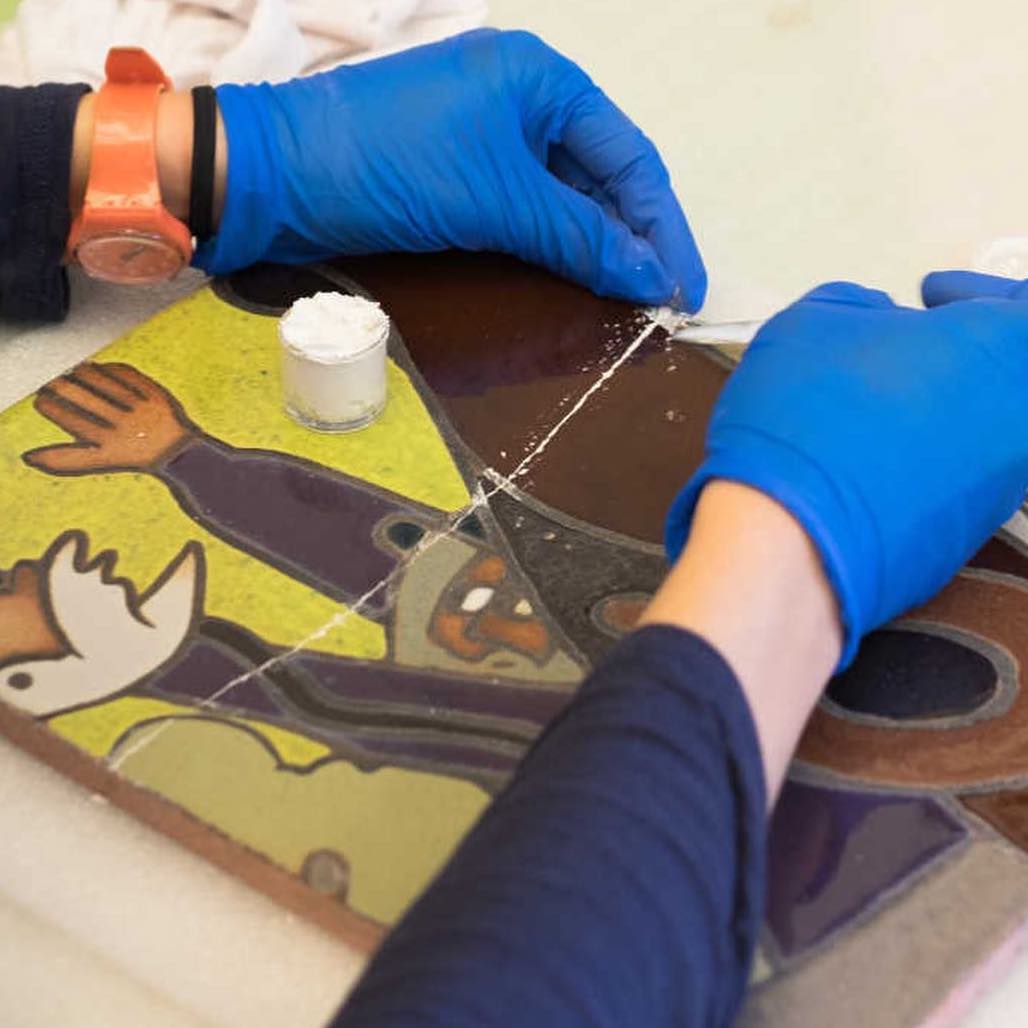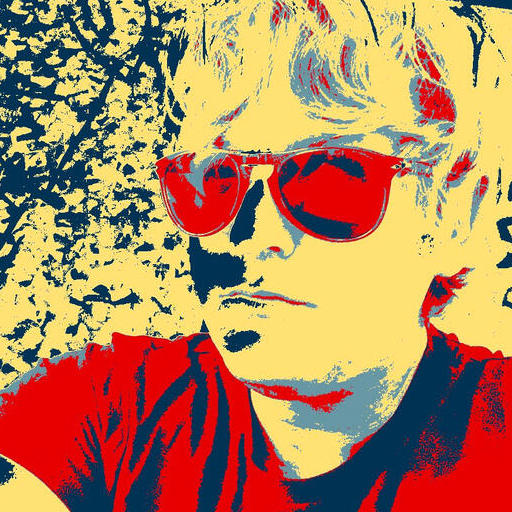The Monterey Mural
Synopsis
This colorful tile mural, chronicling the history of Monterey, California, was created by Guillermo (Bill) Wagner Granizo. Commissioned by the community, the panoramic mural is displayed outdoors on the west wall of the Monterey Conference Center along Pacific Street and features dozens of scenes illustrating the history of (Alta) California and it’s first capital.
The California muralist Granizo displays a dazzling palette of colors and equally impressive knowledge of local history, which marches chronologically from left to right for 48 feet (14.5 meters). From the founding of Monterey in 1770 by Portolá and Serra to the Gold Rush, the mural captures major events and movers/shakers from the Spanish, Mexican and early American eras. The 20th Century scenes are populated with the likes of Crosby, Morse and Steinbeck and all the Monterey area is known to offer, at least up until the Mural’s unveiling by the City of Monterey in 1984!
Thirty years later — while the Conference Center was being renovated — the tiles were restored and then reinstalled in 2018 very near its original location on the northeast corner of Del Monte Avenue and Pacific Street in downtown Monterey. Now at ground-level, the sweeping detail of Granizo’s genius can be enjoyed by everyone. Stop by and take a look!
“The Monterey Mural is a stupendous work...a large panorama of the history of Monterey, depicted with Granizo’s special humor. So many people and events colorfully depicted that some are hidden in plain sight, some deliberately by the artist. Spend time with the Mural. Let it tell you its story, which is our story. The Mural truly is Monterey, an icon of who and what we are...as a place, a people and a community.” — Dennis Copeland, historian
Lead Photo
The Mural Chronology
Granizo had keen personal and professional interests in the history of California. Born in San Francisco, he lived with his family in multiple Central American countries, learned multiple languages and was exposed to many cultures. After returning to San Francisco, he lived his entire adult life around the Monterey and San Francisco Bays. He clearly took an opportunity to illustrate the history of both the region and the state using Monterey, the provincial capital, as his canvas.
Like the rest of the “New World”, (Alta or Upper) California’s history is marked by waves of exploration and migration. However, colonization was undertaken here centuries later than the Atlantic coasts of the Americas, primarily due to the long distances from Europe, across forbidding terrains and seas. From the European point-of-view during the golden Age of Sail, the North American Pacific coast was one of the most distant places on Earth — a voyage that could last an entire year.
Time, as we know it, progresses from left-to-right in the Mural...all 48 feet of it. Alta California history can be described as four successive periods of control, from the European perspective.
- Pre-Colonial — While this period should be named for the first Californians, descendants of nomadic migrations from northeast Asia more than 10,000 years ago, our written history is dominated by European exploration and land claims, particulary by Spain, beginning with Cabrillo in 1542.
- Spanish Settlement — The first successful European settlements were established by the Portolá and Serra expedition, in San Diego and Monterey, in 1769 and 1770, respectively. While a few pueblos or civilian settler communities were developed, Spanish colonial strategy in Alta California was centered on the Mission system founded by Serra.
- Mexican or Rancho period — Mexico achieved independence from Spain in 1821, 300 years after the fall of the Aztecs. Independence brought liberalization in immigration, trade and land ownership policies and secularization of the Missions.
- Americanization — Twenty-five years later, in 1846, the United States occupied Monterey as part of the war provoked by President Polk. Under the Treaty of Guadalupe Hidalgo, the U.S. acquired most of the territory of Alta Califiornia and Texas for $15 million, roughly 5 cents per acre. Then the Gold Rush started, which changed everything.
These four historical periods provide context for the many subjects and scenes Granizo portrayed on his terracotta tapestry. An organized inventory or catalog of the mural’s massive menagerie is under construction on this site. To aid interpretation and commentary, three sections of the mural allow one to trace the contours of Granizo’s composition, highlighting the settlement of northwestern Nueva España, the trade and immigration during the Mexican and early American periods, and later development as part of the United States.
I. Entrada al Edén
Spain’s entrada or entry into Alta California was a last gasp from its already over-extended empire in the New World. While the missions were being established in Alta California, the United States was already fighting for its independence from England. Mexico completed its own war of independence from Spain in 1821, only a half-century after the founding of Monterey. The first peoples of the Pacific coast developed diverse, rich cultures over many millenia, but were overwhelmed by the Europeans’ guns, germs and steel. The indigenous populations collapsed during the first century of colonization; while difficult to establish and still widely debated, probably by a factor of 10.

by Alia Sovereign
 Some rights reserved.
Some rights reserved.
In the first third of the mural, Granizo frames a large roundhouse, a cultural centerpiece of the community, with an explorers’ ship and a longboat, on the (house or viewers’) left and top, respectively. To the right of his tableaux of Ohlone life, Granizo reenacts the “Founding of Monte Rey” and presents the Royal Presidio Chapel, the historic anchor of the original Monterey Presidio. Granizo memorializes the tragic fate of thousands upon thousands with two burial scenes to the left and right of the Chapel, the latter obviously Christian. He writes his longest text on the explorers’ jib, in Spanish:
Estos caballeros fueron los precursores de un nuevo dios, una nueva cultura, un nuevo lengua y el fin del paraíso aborigen. [Translated: These knights were the heralds of a new god, a new culture, a new tongue and the end of an aboriginal paradise.]
II. “Years before the Mast” in the Age of Sail
As Columbus first learned, establishing a New World colony is not the same as keeping one. While Monterey was deliberately founded on the return leg of Spain’s Manila gold trade, this infrequent, but critical, economic support for the Spanish empire was already in decline. Indigenous rebellions along the de Anza trail and Mexico’s decade-long fight for independence also weakened the young colony’s long supply lines.
Dominating the mural’s left-of-center is a huge wooden ship or galleon unloading its precious cargo; the fugacious Mission (or Spanish) and Rancho (or Mexican) periods end to the left of the galleon and the American period(s) begin on the right. The galleon features a tile-mural-within-a-mural on its stern; in the bottom-right tableaux there, Granizo drew a 49er, the quintessential, mythos-making, California gold seeker.
Granizo’s galleon may represent (at least) three concrete or conceptual ships: the afore-mentioned Manila galleons, Bouchard’s La Argentina from the “Battle of Monterey” — Granizo shows cannons being fired from the quarterdeck (!), and the traffic generated by Mexico’s liberalized trade policies — leading to Monterey’s Custom House and the text along the waterline: “came other ships from many lands[,] steam and iron were in their cargo.”
III. The American Centuries
After the rapid and largely peaceful occupation, conquest and acquisition of California by the United States, suddenly “Eureka!” is a yell heard ’round the world. The boom-and-bust cycle of the world’s fifth-largest economy is firmly established by the Gold Rush. California’s resources attract people from all over the world, but Yankee dominance kindles native massacres and dispossession of the Californios and others.
Between losing claim to the capital and the Gold Rush, Monterey’s population drops and its historic adobes empty. (The upper-third of the mural in this section is even less populated that the others.) Granizo placed Colton Hall in the center of a set of now-well-preserved 19th Century buildings, where he wrote “as the pueblo grew, a new era evolved”.
The second half of the 19th century quickly gives way to the 20th, where Granizo fills the final third of the mural, [re]marking on the side of the Sloat Monument (perhaps resuming the previous text): “[...]fishermen, cattlemen, educators, authors, artists [and] vendors flourished.” Granizo returns to Monterey’s waterfront with a crowded diorama of Fisherman’s Wharf and the harbor in the foreground, surrounded by water sports and other leisure pursuits. Cannery Row is in the background, largely silent as it was before the opening of the aquarium.
Granizo certainly succeeds in capturing the important role of Monterey in California, providing a vibrant, tangible record of our history — an expansive view of what has been and continues to be one of the most visually stunning and engaging parts of our Pacific coast. Whether you are just downtown in Monterey or planning a trip on or near The Path of History, please use the Mural as a “super-sized” brochure or guide.
About maestro Granizo
Christened William Joseph Wagner, Granizo was born in San Francisco on March 11, 1923 — the first-born son (but second child) of Dora Granizo and Joseph Wagner, who were Nicaraguan and German, respectively. His family moved south to be with his mother’s family and to chase his father’s dreams of Aztec gold. They lived in central America for over a decade, returning to San Francisco with Granizo, a 13-year-old teenager speaking Spanish and German, but without his older sister, Dorita, who died at the age of 12 of typhoid. Granizo would remain influenced by his sister’s fanciful stories, Maya stelae and the vibrant colors of the native weavings and pottery he experienced as a child. He claimed to have used 250 different glazes in the Monterey Mural!

For all those who admire him and his work, Granizo thoughtfully left behind an autobiographical series of over 100 small (3-by-3-foot) ceramic tile murals. The artist’s self-portrait shown here is one of the “tile paintings” in the series. The artist’s sons, Ron and Bob (also a muralist), posthumously published this “life series”, including descriptions of the tile paintings written by Granizo himself, as an illustrated autobiography on Amazon.
While brief, the first person reminiscences and dream explorations are enchanting and provide fascinating insights into the maestro’s life and work. There are a few pages describing major works, like our very own Monterey Mural, but a more complete, retrospective exploring his legacy is still to be written. You can also see the autobiographical series and the mural descriptions on his website, GranizoArt.com! Much of the material recounted herein is based on this autobiography.
The Garfield Library at the University of Pennsylvania also hosts a presentation of his life series. Dr. Eugene Garfield, patron of the arts and founder of the Institute for Scientific Information and The Scientist, commissioned one of Granizo’s largest works, the Cathedral of Man, prominently displayed at ISI headquarters in Philadelphia.
Drafted into the Army during World War II, Granizo was wounded on Utah Beach during the Normandy landing. He first took up painting as therapy while in hospital, recuperating from his wounds and surgeries over 3 years. He was discharged from the Army in San Francisco with a pregnant wife, a new home and studies at the College of Art — the last two funded by the GI Bill.
While Wikipedia currently lists less than a dozen major public works, Granizo was prolific. The artist created over 7,000 murals, producing 500 murals/year during the height of his career in the 1980s. If he didn’t have a paying commission, he would still create and donate the new work to children’s hospitals or give them to friends. Most of his work is not as large as LA’s Olympic Fantasy or The Monterey Mural, ~2200 and 480 ft², respectively, but many are larger than the panels in the life series, each 9 ft².
On the Web and Elsewhere
-
“Last stop of a great wanderer” by Jim Lessenger, Benicia Herald, .
After moving his home and studio to Benicia in 1985, Granizo soon embarked on a series portraying prominent early Benicians, including the Vallejos, Thomas Larkin, Robert Semple and Charles Stone, for the Benicia Historical Museum.
-
“Civic Auditorium Mural to be Unvieled in August”, The [Santa Cruz] Sentinel, .
“I hoped by doing something of this quality, it would get the city pregnant, and they would have to give birth to many murals by many, many artists.”
-
“Eight Tons of Fine Art Makes for a Weighty Inheritance” by Brian Gaffney, Strange Inheritance, April 17, 2017.
“He just never saw his death coming. Or his work, for that matter, going away. He used to say, ‘It took 2,500 degrees to make this tile. At the end of the world, it may not be that hot. My art will be still standing.’” — Bob Wagner, muralist and Granizo’s son
-
“William Wagner Granizo”, San Francisco Examiner (on-line edition), .
More about the Mural
Physical characteristics
As it marches through Monterey’s history, the al fresco mural reaches almost 48 feet — it’s 574 inches wide. Some sources describe it as 11 feet tall, but is actually slightly less than 10 — 117 inches, exactly. The content of the mural is represented on 549 9-by-12-inch terracotta tiles — a format Granizo used in many of his works, including his autobiographical life series. The “tile canvas” includes nine rows of these 9-by-12 tiles, which ends up being almost 10 feet tall when you include the small tile frame or border that Granizo handcrafted for his masterpiece and add the grout between the tiles.

The above image shows the content of the first (left-most) physical panel of the Mural; this panel also includes 19 border tiles. In the current installation, there are a total of 124 separate border tiles that frame the content, making the grand total number of tiles in the Mural equal to 673.
This image also shows there are six sections of the Mural that have an additional physical separation from each other on the exterior wall. These physical panels provide an additional approach to organize or catalog the mural content.
Repair, Restoration and Relocation

The Mural has been restored twice in its 37 years, in 2009 and 2015. Both renovations were performed by the award-winning firm ARG Conservation Services of San Francisco.
The second rehabilitation was extensive. In addition to repair and cleaning, complete removal was required to prepare for the reconstruction of the Conference Center; thanks to the loving care of ARG Conservation Services, only 65 tiles sustained damage. The tiles also required a substantial stay in storage until relocation and reinstallation were complete in the fall of 2018. Local firm C.L. Frost did the install.
During the first restoration, the conservators found tiles that had cracked as the building settled over the years and the exterior wall spread apart. Given the opportunity to design a new installation, ARG Conservation Services recommended not laying any tile over any expansion joints and championed the creation of six separate sections in the anchoring or backing wall to improve the Mural site stability and sustain its integrity.
The Mural’s return was celebrated on November 29, 2018, with tributes by community leaders and the Granizo family. Still only a few steps off Monterey’s Path of History at the corner of Del Monte and Pacific, Granizo’s tile tour de force continues to delight the eyes.
Sources and further reading
-
“...” by XXX
-
“The Monterey Mural” by Thom Diggins
Thom digs into The Monterey Herald archives for some great background on the making of the mural.
-

“The Monterey Mural Lives On” by Ron Wagner, Granizo’s son
“The Monterey Mural was a significant accomplishment for my dad and one that was very important to him personally. He put his heart, soul and humor into this mural. As you walk around and observe all of the stories that he had incorporated into the mural, you will be in awe of his talent and humor. The mural remains a beautiful piece of public art, and like all his works, one made for people to enjoy.”
-
“An iconic work of local public art is returning to its rightful spot after a long absence.” by Walter Ryce, Monterey County Weekly, .
“There is a Where’s Waldo degree of commotion, but it’s balanced like a meticulous church stained glass. It’s a marvel.”
-
“Monterey’s Iconic Tile Mural Returns” by City of Monterey
“The first most asked question [about our conference center renovation has been] ‘What did you do with that mural and when is the mural coming back?’ 663 tiles depict 150 scenes from Monterey’s history. The things you can discover! It’s just plain fun.” — Clyde Roberson, Mayor
-
“Monterey’s Monumental Mosaic Mural Memorializes Marauding Mariners & More” by David Laws
“...just a few yards off the [beaten, Ed.] Path of History, facing historic Casa Soberanes (aka The House of the Blue Gate), The Monterey Mural offers a colorful and entertaining presentation of local history.”
-

“The Monterey Mural, Monterey CA” by WalruZ
While the photos show the mural’s original installation, the location is close enough that the geo-coordinates should still be good enough to get you there.
-
“Monterey Conference Center gets back its historical mural” by Carly Mayberry, Monterey Herald, .
-
“Monterey Mural at conference center to be restored” by Tom Wright, Monterey Herald, .
-
“Brighter Mural: Renovation completed at conference center” by Kevin Howe, Monterey Herald, .
-
“Applause Greets New Monterey Mural” by Joe Graziano, Monterey Herald, .
-

“(Short Overview of) California Indian History” by Edward D. Castillo, .
Tips-of-the-Hat
-
“...” by XXX
-

“Where the World builds Websites” by GitHub Pages
GitHub supports over 50 million developers wrangling code in over 100 million source repositories — literally, “where the world builds software”. You can leverage their world-class, bleeding-edge infrastructure platform to host websites like this one directly from your repo using GitHub Pages. You can find the code for this website on its project page. Pssst! GitHub’s basic package for team and individual accounts is free!
-

“The Monterey Mural” by Dana Brown
Photographing art is always challenging, but when the piece is 480 ft², with a 5:1 aspect ratio, and outside, it requires talent and experience. Dana Brown is an accomplished Bay Area photographer and filmmaker, whose lens caught the Mural on a recent visit to foggy Monterey. He posted his fine panorama on Flickr, providing a powerful viewing tool that aids detailed study. Mr. Brown also licenses his photographs in the Creative Commons. Thank you!
